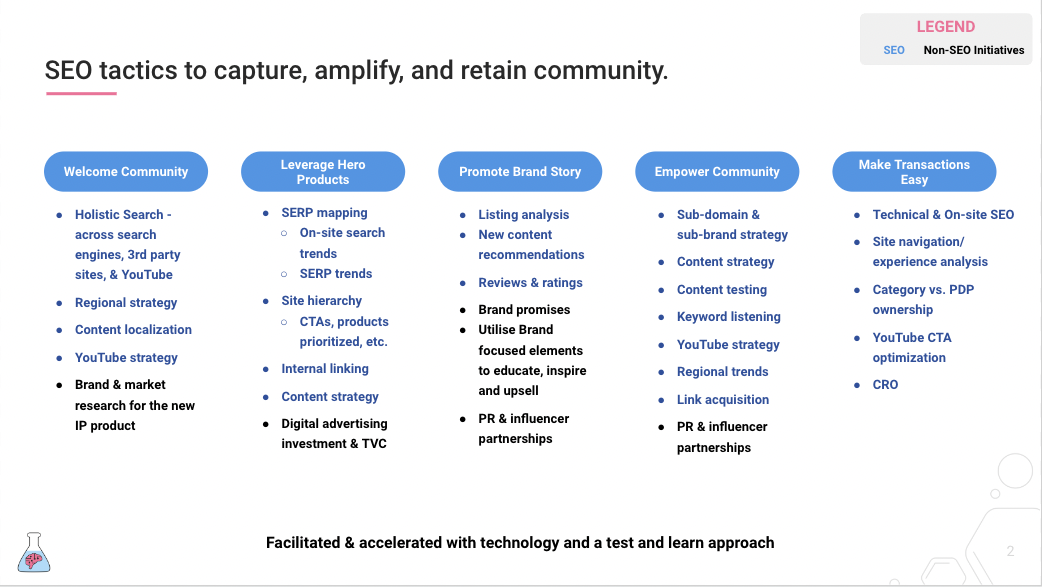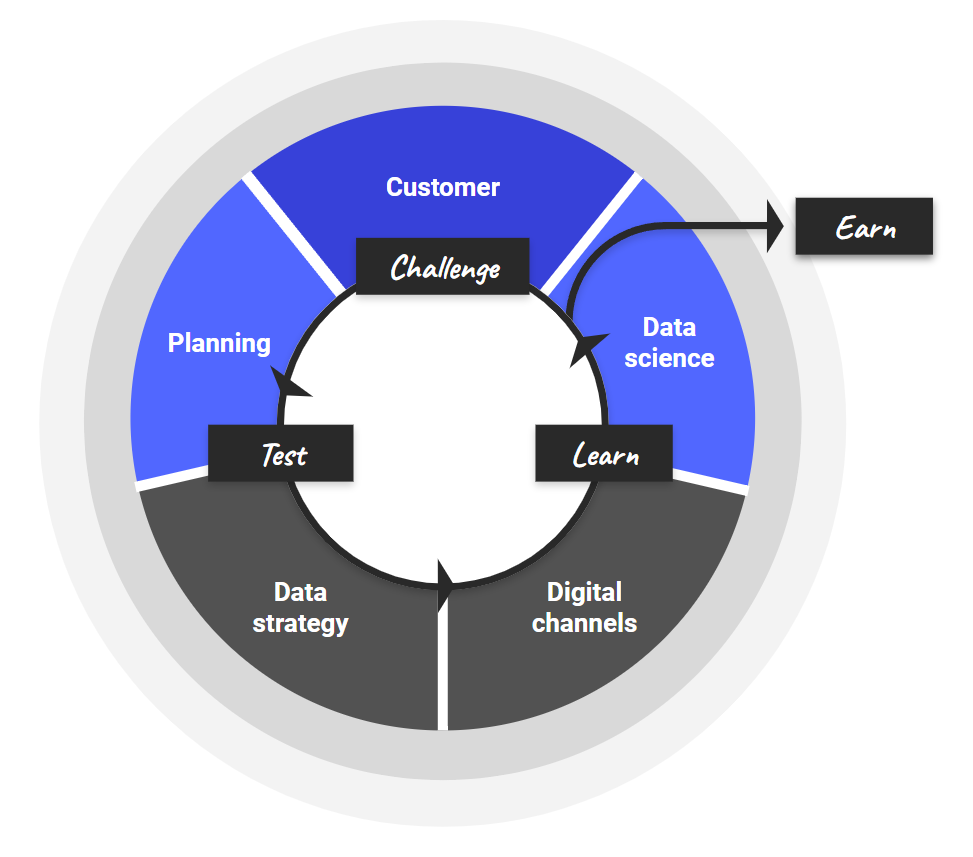
Use SEO to Fuel Your Brand's Community Flywheel
The author's views are entirely their own (excluding the unlikely event of hypnosis) and may not always reflect the views of Moz.
I don’t typically wear jewelry. However, when I heard a friend rave about the ring and necklace he bought from Automic Gold, it piqued my interest. As I scrolled through the site, I found myself very engaged by the approachable content, fun styles, and lifestyle photos showing inclusive genders. After several site visits, I made a purchase.
This experience is a prime example of how a brand can influence purchasing decisions through community marketing. No ad was seen. No ad was clicked. I not only became a customer, but I also became a fan of this brand—all driven by my friend’s recommendation alone.
We live in an era of community marketing, and community marketing is built through brand stories. Performance marketing efforts are still a fundamental component of marketing, but they become far more effective with a personal endorsement from a friend. After all, social proof is one of the most powerful marketing engines. In fact, according to a Nielsen Harris Poll study, 82% of Americans say they seek recommendations from friends and family when considering a purchase. Today’s most successful brands have built followings that not only return to purchase again, but also promote their products or services loyally — think of LEGO (85% loyalty rate), Apple (with 90% loyalty rates), and REI (50M+ lifetime members), to name a few. Airbnb just posted its stunning results after shifting focus to brand marketing rather than performance marketing.
Introducing the community flywheel
The community flywheel is an approach that easily marries brand and performance marketing efforts. You don’t have to be a big-name brand to see results from this strategy. No matter how niche your audience is, by leveraging your digital assets, you can cultivate an inviting community space. The key to success is building a community you own.
Brands typically think of social platforms like Instagram or Twitter as the gathering place for their community. While these platforms play an important role in amplification and social proof, your website should be a communal gathering place for your brand. It can and should be a place to educate, engage, and entertain your audience. Owning first-party data and the platform where engagement occurs is worth far more in the long run and eliminates risk outside of your brand’s control.
SEO has a pivotal role in the success of a website, and thus SEO also plays a pivotal role in the community flywheel’s success. In this article, I will explain the community flywheel and outline how SEO fits into each step of the community flywheel.
What is the community flywheel?
The community flywheel outline by McKinsey & Company succinctly explains how brands can build better communities, which in turn builds a better brand. It’s a five-step process underpinned by technology that enables scale and a test-and-learn approach that delivers consistent improvement. To align SEO initiatives for each of the 5 steps, I’ve created this graphic showing how initiatives apply to each step.

Let’s unpack each of the steps in the community flywheel. I’ll explain what each step is, how to implement it, and how SEO applies. I’ve provided common SEO deliverables that support each of these steps; however, this is by no means an exhaustive list. I hope this inspires you to integrate even more SEO initiatives—some possibly even more applicable to your brand—into your community marketing efforts.
1. Community Focus: Find the right audience
What it is
Identify communities of shared interest and, in marketing efforts, find ways to help them identify with and have an emotional response to the communities they belong to. Understanding the core target audiences beyond demographics is the key to knowing how the audience interacts. As noted in the McKinsey article, “This is an evolution from targeting consumer segments, which are anchored in demographics or individual need states, to targeting communities of people who share similar interests and values—communities of ‘shared relevance.’”
How to do it
Once you know the community(ies) you’re trying to target, build campaigns that speak to the group as opposed to the individual. Community marketing connects emotional marketing to a group that bonds together.
How SEO plugs in
Audience research is your key to understanding the cohort(s) that interact with the site. Using a tool like Sparktoro can lend insight into how your audience interacts with a particular topic. After audience research is complete, begin SEO initiatives that bolster community engagement so you can build a strategy that targets each community where they’re at in their search journey.
Holistic Search Analysis: It’s vital to understand how the audience is interacting throughout the purchase journey within SERPs, your site, and even third-party sites like Amazon. Conducting a holistic search analysis to understand where searches happen across Google, Amazon, YouTube, and other sites is key to knowing where to prioritize your SEO efforts.
Regional Strategy: If you have a site that covers multiple regions, creating transcreated content — content that speaks to the audience the way the audience would speak — is a must for ensuring you have a community focus.
YouTube Strategy: If your brand has an active YouTube presence, it’s worthwhile to explore which keywords populate video results in the SERPs and which keywords are most commonly searched within YouTube so you can build this into your SEO strategy and conduct YouTube SEO.
2. Hero Products: Simplify the brand & boost average order value (AOV)
What it is
Shopping online can require much more thought than shopping in a store. You’re faced with many more options, including figuring out the shipping costs, timelines, etc. It’s cumbersome. Leveraging your brand’s best hero products to define your brand simplifies the brand message to your community.
How to do it
This doesn’t mean leaving hero products on the back burner to evaporate — it means reinvesting in new and interesting campaigns to bring them to light again. This can be done through collaboration campaigns, reinvigorated marketing campaigns, or even repositioning to new communities.
How SEO plugs in
While UX and site hierarchy certainly play an important role in hero product advancement, SEO can support hero product advancement by taking that type of analysis one step further: how are people interacting with hero products off-site, in the SERP, and on the site?
SERP mapping: Identifying which hero product keywords trigger competitors, resellers, SERP features, etc., is a great way to ensure that hero products are shown as you desire within the SERP.
Site journey analysis: Understanding how folks navigate the site allows you to boost average order value by highlighting hero products or boosting less well-known products by leveraging hero product traffic.
Internal linking: Using hero products to acquire backlinks and then creating internal links to less-linked pages can boost keyword ranking for other pages/products.
Content strategy: Understanding how to incorporate hero products into the entire content funnel—from awareness tactics like user guides to post-conversion tactics like return policies or help center content—can boost conversion rates and customer sentiment.
3. Brand Story: Give people something to relate to & be proud of
What it is
Few want to buy from a brand that doesn’t align with their values. In fact, we see that the majority of shoppers under the age of 56 have favorable attitudes toward brands that have clear involvement in social and political issues.
Make it an easy decision for your community to purchase from you by outwardly communicating your brand values in a way that your audience would understand. This is especially true for brands with an international presence—after all, what may be sneakers in the US are trainers in the UK.
Here is an example from Automic Gold of communicating clear brand values:

How to do it
Communicating clear brand values on the site, in brand messaging, and amplifying those tactics through media pushes is a fantastic way to communicate the brand values across the community(ies).
How SEO plugs in
Most brand stories are typically left to the PR and/or brand teams to own, but SEO can play a pivotal role in amplifying those efforts and even fueling their expansion.
Listing Analysis - Understanding what is showing up in the SERPs for various search terms allows us to know what efforts to focus on—e.g., if we know publishers appear in top positions, then we should relay that information to the PR team to focus on getting placement in those publications.
- Schema - Schema impacts how the listing appears in the SERPs, which leaves plenty of room for a brand to utilize schema to own more real estate in the SERP.
FAQ schema - FAQ pages and schema are an easy way to answer questions related to the brand—e.g., “Who is the CEO of [brand]” etc.?
Help Center schema - Usually, help centers are the last thing to be optimized for SEO, but building a community means ensuring a great experience from start to finish. Optimizing the help center—inclusive of schema—is an easy way to help people get easy access to information related to their search queries directly within the SERP.
E-A-T efforts - The more the brand story is consistent and amplified across channels, the better the expertise, authoritativeness, and trustworthiness (E-A-T) will be because Google will be able to understand the brand entity better.
4. Fuel Community: Build a gathering place
What it is
The end goal is to build a community space where your community(ies) can interact and create user-generated content that can then be used to amplify your brand message. Nevertheless, a car won’t move forward without fuel. Building a consistent content strategy that communities can latch onto and use as their own provides the fuel to generate community engagement.
How to do it
Investing in tactics that can enable brand marketing teams and bring the community together on your site is the best way to fuel community. We typically think of “community engagement” happening on social media platforms, but who says that your website can’t create its own community with regularly engaged and recurring community members? Some excellent examples include LEGO IDEAS, Sphero Edu, Sephora's Beauty Insider, and F5’s DevCentral community. No matter the industry, you can find unique ways to create a community space on your website.
How SEO plugs in
SEO alone can’t fuel community. Much of this has to be done across channels, including email campaigns, packaging, etc., but SEO supports these efforts in some key ways:
Blog strategy - One of the best ways to engage with your audience and build community is through a compelling and consistent blog strategy that educates, entertains, and/or engages the community in a unique way. I’d encourage easy share buttons, simple call-to-actions, and an engaged comments section.
Forum strategy - Forums are a great way to engage with your community and allow the community to bond with others.
Review strategy - Reviews help bolster social proof and support the community flywheel by allowing folks an outlet to share their experience with your brand.
Keyword listening - When new products are launched, or a brand evolves, related search trends may also change. Using keyword listening is your way to stay ahead of trends and use user-generated search queries to inform new site content generation.
User-generated content - While we typically think of UGC as social media content, we can absolutely use UGC on the site by fueling content strategy, or even by allowing noteworthy guest contributors on your site.
5. Effortless Transactions: Make it easy to engage
What it is
Transactions look different throughout the entire marketing funnel. At the top of the funnel, it might be a cookie drop for retargeting. In the middle of the funnel, it might be email or phone data capture. At the bottom of the funnel, it might be purchase or lead form submission. Regardless, it should be seamless for customers to transact at any place in the funnel. This allows the community to have a pleasant experience throughout.
How to do it
Investing in conversion rate optimization efforts to smooth the path to site conversion, technical SEO to ensure the site experience is seamless, and on-site SEO to ensure that the right pages for the right search query are your way to make transactions easy.
How SEO plugs in:
Effortless transactions also include things like digital wallets and using pay-later tools, but SEO efforts—inclusive of technical site performance—can certainly impact transactions more than most other efforts.
Technical SEO - Focusing on things that allow for better page indexation and page experience (like site speed) boosts the likelihood of a user landing on the right page and not bouncing from poor UX.
On-site SEO - Content and internal links on the page can help the user navigate from discovery to purchase without confusing them.
YouTube CTA optimizations - For search results that have video results, including CTAs in the videos and ensuring the links are up to date is an easy way to smooth the path to conversion.
YouTube video chapters - Including video chapters—or even auto-enabling them—allows Google to highlight the correct section in a video for a user, which gets them their answer even faster.
Make the wheel spin faster with technology
Finding the right tech stack to get data faster and validate strategy more quickly is the difference between doing good SEO and great SEO. Data capture and measurement have to be a priority in SEO efforts so you can perform analysis faster than ever before. Using your CRM database to analyze existing customer information and pairing that with a purchase journey analysis can inform how your existing community interacts with your site.
Additionally, SEO A/B testing tools like SearchPilot are a great way to understand the impact of SEO and CRO tests on net new traffic and conversions without bogging down development teams.
Validate the community flywheel with a test-and-learn approach

At Brainlabs, we use a test, learn, and earn approach to guide our initiatives. This model fits nicely into community marketing because we’re constantly testing new methods to engage with a brand’s community. We know that a customer interacts with various digital channels as their needs evolve over time. While SEO can be utilized to enable the community flywheel, it’s imperative to use a test-and-learn strategy so you can continue to find the right media mix to reach your goals.
Leverage SEO to make the community flywheel spin
Community marketing is here to stay. It’s been the most effective marketing tactic since the beginning of marketing. Building a community doesn’t happen overnight, but integrating these SEO strategies within each step of the community flywheel is a great way to improve your CPAs, increase your AOVs and LTVs, and build a brand that stands the test of time.



